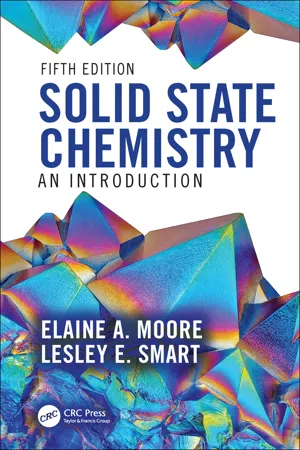
- 442 pages
- English
- ePUB (mobile friendly)
- Available on iOS & Android
About this book
Solid State Chemistry: An Introduction 5th edition is a fully revised edition of one of our most successful textbooks with at least 20% new information.
Solid-state chemistry is still a rapidly advancing field, contributing to areas such as batteries for transport and energy storage, nanostructured materials, porous materials for the capture of carbon dioxide and other pollutants.
This edition aims, as previously, not only to teach the basic science that underpins the subject, but also to direct the reader to the most modern techniques and to expanding and new areas of
research. The user-friendly style takes a largely non-mathematical approach and gives practical examples of applications of solid state materials and concepts.
A notable and timely addition to the 5th edition is a chapter on sustainability written by an expert in the field. Examples of how solid state chemistry contribute to sustainability are also given in relevant chapters.
Other new topics in this edition include cryo-electron microscopy, X-ray photoelectron spectroscopy (ESCA) and covalent organic frameworks.
A companion website offering accessible resources for students and instructors alike, featuring topics and tools such as quizzes, videos, web links and more has been provided for this edition.
Frequently asked questions
- Essential is ideal for learners and professionals who enjoy exploring a wide range of subjects. Access the Essential Library with 800,000+ trusted titles and best-sellers across business, personal growth, and the humanities. Includes unlimited reading time and Standard Read Aloud voice.
- Complete: Perfect for advanced learners and researchers needing full, unrestricted access. Unlock 1.4M+ books across hundreds of subjects, including academic and specialized titles. The Complete Plan also includes advanced features like Premium Read Aloud and Research Assistant.
Please note we cannot support devices running on iOS 13 and Android 7 or earlier. Learn more about using the app.
Information
1 An Introduction to Crystal Structures
1.1 Introduction
1.2 Lattices and Unit Cells
1.2.1 Lattices

1.2.2 One- and Two-Dimensional Unit Cells
Table of contents
- Cover
- Half-Title
- Title
- Copyright
- Dedication
- Contents
- Preface to the Fifth Edition
- Preface to the Fourth Edition
- Authors
- Contributors
- List of Units, Prefixes, and Constants
- Chapter 1 An Introduction to Crystal Structures
- Chapter 2 Physical Methods for Characterizing Solids
- Chapter 3 Synthesis of Solids
- Chapter 4 Solids: Bonding and Electronic Properties
- Chapter 5 Defects and Nonstoichiometry
- Chapter 6 Solid-State Materials for Batteries
- Chapter 7 Microporous and Mesoporous Solids
- Chapter 8 Optical Properties of Solids
- Chapter 9 Magnetic and Electrical Properties
- Chapter 10 Superconductivity
- Chapter 11 Nanostructures
- Chapter 12 Sustainability
- Answers to Questions
- Further Reading
- Index